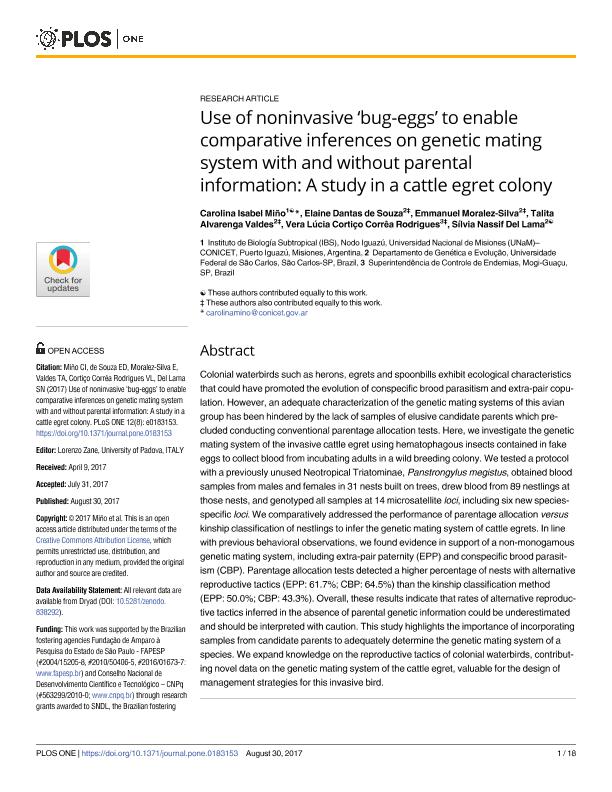Artículo
Use of noninvasive ‘bug-eggs’ to enable comparative inferences on genetic mating system with and without parental information: A study in a cattle egret colony
Miño, Carolina Isabel ; Dantas de Souza, Elaine; Moralez-Silva, Emmanuel; Valdes, Talita Alvarenga; Cortiço Corrêa Rodrigues, Vera Lúcia; Del Lama, Sílvia Nassif
; Dantas de Souza, Elaine; Moralez-Silva, Emmanuel; Valdes, Talita Alvarenga; Cortiço Corrêa Rodrigues, Vera Lúcia; Del Lama, Sílvia Nassif
 ; Dantas de Souza, Elaine; Moralez-Silva, Emmanuel; Valdes, Talita Alvarenga; Cortiço Corrêa Rodrigues, Vera Lúcia; Del Lama, Sílvia Nassif
; Dantas de Souza, Elaine; Moralez-Silva, Emmanuel; Valdes, Talita Alvarenga; Cortiço Corrêa Rodrigues, Vera Lúcia; Del Lama, Sílvia Nassif
Fecha de publicación:
08/2017
Editorial:
Public Library of Science
Revista:
Plos One
ISSN:
1932-6203
e-ISSN:
1932-6203
Idioma:
Inglés
Tipo de recurso:
Artículo publicado
Clasificación temática:
Resumen
Colonial waterbirds such as herons, egrets and spoonbills exhibit ecological characteristics that could have promoted the evolution of conspecific brood parasitism and extra-pair copulation. However, an adequate characterization of the genetic mating systems of this avian group has been hindered by the lack of samples of elusive candidate parents which precluded conducting conventional parentage allocation tests. Here, we investigate the genetic mating system of the invasive cattle egret using hematophagous insects contained in fake eggs to collect blood from incubating adults in a wild breeding colony. We tested a protocol with a previously unused Neotropical Triatominae, <em>Panstrongylus megistus</em>, obtained blood samples from males and females in 31 nests built on trees, drew blood from 89 nestlings at those nests, and genotyped all samples at 14 microsatellite <em>loci</em>, including six new species-specific <em>loci</em>. We comparatively addressed the performance of parentage allocation <em>versus</em> kinship classification of nestlings to infer the genetic mating system of cattle egrets. In line with previous behavioral observations, we found evidence in support of a non-monogamous genetic mating system, including extra-pair paternity (EPP) and conspecific brood parasitism (CBP). Parentage allocation tests detected a higher percentage of nests with alternative reproductive tactics (EPP: 61.7%; CBP: 64.5%) than the kinship classification method (EPP: 50.0%; CBP: 43.3%). Overall, these results indicate that rates of alternative reproductive tactics inferred in the absence of parental genetic information could be underestimated and should be interpreted with caution. This study highlights the importance of incorporating samples from candidate parents to adequately determine the genetic mating system of a species. We expand knowledge on the reproductive tactics of colonial waterbirds, contributing novel data on the genetic mating system of the cattle egret, valuable for the design of management strategies for this invasive bird.
Archivos asociados
Licencia
Identificadores
Colecciones
Articulos(CCT - NORDESTE)
Articulos de CTRO.CIENTIFICO TECNOL.CONICET - NORDESTE
Articulos de CTRO.CIENTIFICO TECNOL.CONICET - NORDESTE
Articulos(IBS)
Articulos de INSTITUTO DE BIOLOGIA SUBTROPICAL
Articulos de INSTITUTO DE BIOLOGIA SUBTROPICAL
Citación
Miño, Carolina Isabel; Dantas de Souza, Elaine; Moralez-Silva, Emmanuel; Valdes, Talita Alvarenga; Cortiço Corrêa Rodrigues, Vera Lúcia; et al.; Use of noninvasive ‘bug-eggs’ to enable comparative inferences on genetic mating system with and without parental information: A study in a cattle egret colony; Public Library of Science; Plos One; 12; 8; 8-2017; 1-18
Compartir
Altmétricas



